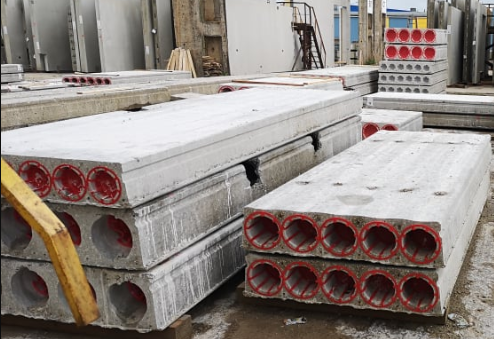Every large-scale modern construction project requires you to use speedy, efficient, cost-effective, and sustainable building materials and methods. Keeping that in mind, there have been many advancements in building materials that ensure your buildings not only look aesthetic but also have the structural strength to withstand harsh climates and constant use.
Recently, more and more developers are relying on precast building solutions as they not only provide exceptional durability but also help you meet strict timelines and budget requirements.
Particularly, the hollowcore concrete elements have gained huge traction in the construction sector for their reduced weights, lower cost, easy installation, and a myriad of other benefits.

This blog explores hollowcore concrete in detail, highlighting its key features and the engineering behind its construction. So, without any further ado, let’s get right to it.
- What is Hollowcore Concrete?
- Key Features of Hollow Core Concrete
- Hollowcore Concrete: The Engineering Behind This Innovative Building Material
- Main Applications of Hollowcore Concrete
What is Hollowcore Concrete?
Hollowcore concrete is an innovative building solution that refers to pre-stressed or precast concrete slabs that contain continuous hollow voids called cores running through their length.
The purpose of the voids is to reduce the overall weight of the concrete element without sacrificing its structural strength.
The following is a brief account of the manufacturing process of hollowcore concrete.
- First, high-strength steel tendons or strands are placed along long casting beds.
- Before placing the concrete, these tendons are tensioned in a process called prestressing. This process ensures the final product can resist strong tensile forces.
- After that, low-slump and high-strength concrete is poured over the strands using an extrusion or slip-form machine.
- At this stage, rotating augers or tubes displace concrete to create longitudinal voids, giving you hollowcore concrete.
- After extrusion, the hollowcore concrete is cured by steam or naturally by leaving it to dry. Once the concrete is cured, the tension in the steel strands is released, which transfers the compressive force to the hollow-core concrete slab, completing the prestressing process.
- The prepared long slabs can now be cut to different lengths based on project specifications and transferred to the construction site for installation.
The use of hollowcore concrete in modern infrastructure projects ensures greater precision, faster turnaround times, reduced material wastage, and lower costs, making it the most practical and effective construction material.

Key Features of Hollow Core Concrete
The following are some main features of hollowcore concrete that make it among the most useful precast structural elements.
- Precast and Prestressed
These concrete elements are precast in factories and are prestressed with steel strands to give them greater load-bearing capacities.
- Reduced Dead Weight
The main feature of hollowcore concrete is its longitudinal voids, which not only serve functional purposes but also reduce dead weight to a great extent, making transportation and installation easier, quicker, and safer.
- Modular Design
These structural elements come in both standard and customized modular designs with different thicknesses and lengths to meet your specific precast construction requirements.
- Greater Load Capacity
Hollowcore concrete elements are designed to span long distances of up to 60 feet with minimal support. This is due to their greater load capacity and strength.
- Precision Manufacturing
These concrete elements are made in controlled factory environments, which ensures every piece has surface and internal uniformity as well as dimensional accuracy.
- Fire Resistance
This material offers greater thermal insulation and fire-resistance due to concrete’s inherent fire-resistance features.
- Sustainability
Hollowcore concrete is made from fewer raw materials, and its low weight also reduces fuel consumption during transportation, which makes it an environmentally friendly building solution.

Hollowcore Concrete: The Engineering Behind This Innovative Building Material
What makes hollowcore precast concrete in infrastructure development so special is the engineering that goes into its making. The design of hollowcore concrete is based on structural optimization by only putting material where it is structurally useful.
In most construction applications, stresses are highest at the bottom and the top of the concrete, and the central region experiences little to no stress, and that is what this concrete element leverages upon.
The following are some main engineering concepts involved in the construction of hollowcore concrete.
Prestressed Concrete
The main process involved is “Prestressing,” which is what gives this concrete element exceptional load-bearing strength.
The prestressing process involves tensioning high-strength steel strands before casting concrete. When the concrete hardens and gains strength, the tension is released, which transfers the compressive force to the concrete.
Since concrete is inherently weak in tension, the prestressing allows it to resist the tensile stress which is caused by external loads. Prepressing is also what allows the concrete slabs to span long distances without cracking or deforming.
Hollowcore Geometry
Another factor that is responsible for this concrete element’s unique performance and high structural efficiency is its hollowcore geometry. The design of hollowcore concrete lowers the slab’s self-weight, which leads to lower costs.
Despite being hollow, the upper and lower zones of the concrete still have enough material to handle very high compressive and tensile forces without cracking.
Spanning and Load Distribution
Hollowcore concrete elements behave just like beams or one-way spanning elements that can resist both live loads and uniform dead loads. These can span about 6–18 meters (20–60 ft) in length, and their load capacity ranges between 3–10 kN/m². These features of the hollowcore concrete make it ideal for open-plan designs where using intermediate beams or support systems is not feasible.
Main Applications of Hollowcore Concrete
Here are some major applications of hollowcore concrete that make it a suitable precast building product.
- These are used as foundational or structural elements in apartment or multi-family housing buildings.
- Flooring and roofing systems of office buildings and retail centers use hollowcore concrete elements.
- The high load capacity and long spans of these concrete elements also make them perfect for parking structures.
- Educational and healthcare facilities also utilize this material for efficient and fast-tracked construction.
- These are used in industrial spaces and warehouses to support heavy equipment and loads.
- The strength and quick installation of hollowcore concrete also make it suitable for making bridges, decks, walkways, and other major urban infrastructure elements.
Conclusion
The hollowcore concrete combines intelligent design and material strength to give you a construction solution that is both affordable and more reliable. This material is the result of the innovative engineering that combines the concepts of prestressing, hollowcore geometry, and load distribution over large distances.
This particular concrete element is both durable and lightweight, which makes it suitable for all domestic and commercial construction applications.
The cost-effectiveness, strength, and versatility of hollowcore concrete make it a marvel of modern engineering, and these are also among the many reasons for its worldwide popularity.
Visit Naran Precast Concrete Co. today to get the best precast building solutions and products for all industrial, commercial, and residential applications.

